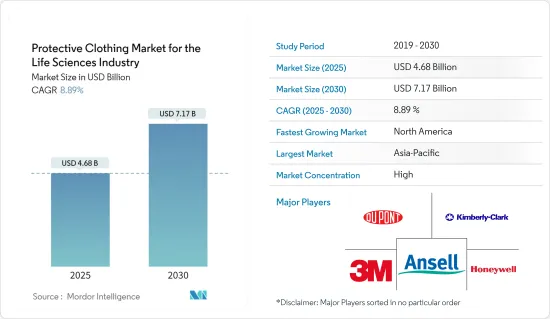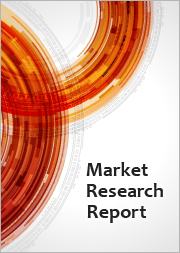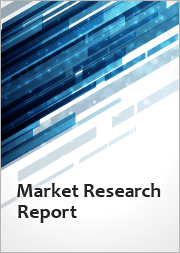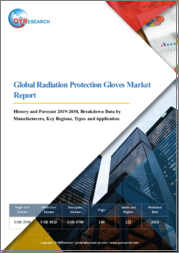
|
시장보고서
상품코드
1685938
생명과학 산업용 보호복 : 시장 점유율 분석, 산업 동향 및 통계, 성장 예측(2025-2030년)Protective Clothing for the Life Sciences Industry - Market Share Analysis, Industry Trends & Statistics, Growth Forecasts (2025 - 2030) |
||||||
생명과학 산업용 보호복 시장은 2025년 46억 8,000만 달러에서, 2030년에는 71억 7,000만 달러로 성장할 것으로 예측되며, 예측기간(2025년-2030년)의 CAGR 8.89%로 성장할 전망입니다.

COVID-19의 세계 보급은 다양한 분야에서 보호복 시장의 성장에 큰 영향을 미쳤으며, 그 영향의 가장 큰 부분은 의료 부문의 판매 및 수요 증가였으며 COVID-19는 건강과 경제에 큰 영향을 미쳤습니다. 처음 시작되었을 때 전 세계적으로 팬데믹이 갑자기 확산되면서 공황 상태에 빠졌고, 단기간에 마스크, 장갑, 안면 보호대, 공기 필터 호흡기, 고글, 가운과 같은 안전 장비에 대한 수요가 크게 증가했습니다.
주요 하이라이트
- 생명과학 분야는 크게 제약, 생명공학, 의료의 세 가지 주요 부문(보호복 용도 기준)으로 분류할 수 있습니다. 일반적으로 생명과학 부문의 상대적 성장은 의료 및 혁신에 대한 지역 시장의 지출과 관련이 있습니다. 현재 시장 시나리오에서 거의 모든 경제, 특히 개발도상국에서는 의료 및 혁신에 대한 지출을 늘리고 있습니다.
- 제약 부문의 새로운 제조 활동으로 인해 전임상 및 초기 단계의 의약품 개발 및 생산 환경에서 사용되는 보호복에 대한 수요가 증가할 것으로 예상됩니다. 예를 들어, 중국 시장은 전임상 및 초기 단계의 의약품으로 활기차고 생명공학 활동의 성장 허브이며 지역적 기회를 창출하고 있습니다.
- 세계보건기구는 의료기기를 질병을 진단하거나 치료하는 데 사용되는 모든 도구라고 정의합니다. 여기에는 수술용 가위부터 심장박동기, 복잡한 스캐닝 장비까지 모든 것이 포함되며, 의료 기기 장비는 물질 취급에 따른 위험도에 따라 클래스 I, IIA, IIB, III으로 분류됩니다.
- 2021년 8월 각 성의 기업들이 PPE 구매를 희망하는 방식은 2021년 5월의 PPE 결과와 대부분 동일하며, 2021년 5월 결과에 따르면 의료 및 사회 지원 부문의 기업들이 부족을 예상하는 것으로 나타났습니다.
- 다양한 정부 기관에서 생명과학 산업에 대한 기업들의 투자를 인정하고 있습니다. 예를 들어, 2021년 10월 UNCTAD는 보건 인프라, 의료 기기, 의약품 및 백신 제조, 개인 보호 장비 생산, 디지털 건강 및 생명과학 연구에 대한 신규 투자를 촉진한 기관에 상을 수여했습니다.
- 또한 레빈 리히트만 캐피털 파트너스의 자회사인 테크니컬 세이프티 서비스(Technical Safety Services)는 2022년 9월 CEPA 오퍼레이션즈(CEPA Operations, Inc.)를 인수할 것이라고 발표했습니다. 이 회사는 캘리포니아주 온타리오에 본사를 두고 있습니다. 이 회사의 서비스는 고객 시설의 수명 주기 전반에 걸쳐 수행되며 클린룸, 바이오 안전 캐비닛, 의료용 가스 시스템, 고순도 물 시스템, 실험실 장비 등과 같은 통제된 환경의 규정 준수 운영을 보장합니다.
보호복 시장 동향
보호 장갑의 사용 증가로 인한 시장 수요 증가
- 장갑은 주로 일회용품으로 사용되는 품목 중 하나입니다. 장갑은 체액, 분비물, 혈액, 배설물에 노출될 위험이 있거나 오염된 장비를 다룰 때 착용합니다. 의사, 간호사, 실험실 기술자와 같은 의료 전문가는 이러한 위험에 노출될 위험이 높습니다.
- 내화학성 장갑은 과산화물, 로켓 연료, 부식성이 강한 산(질산, 황산, 불산, 흄산 등), 강염기, 알코올, 알데히드, 케톤, 에스테르 및 니트로 화합물로부터 보호합니다.
- 천연(라텍스) 고무 장갑은 착용감이 좋아 범용 장갑으로 인기가 높습니다. 인장 강도, 유연성, 온도 저항성이 모두 뛰어납니다. 이 장갑은 대부분의 산, 알칼리, 염분의 수용액으로부터 직원의 손을 보호합니다. 인장 강도, 유연성 및 온도 저항성이 모두 탁월합니다. 이 장갑은 대부분의 산, 알칼리, 염분 수용액으로부터 직원의 손을 보호합니다.
- 의료 분야에서는 병원성 미생물로부터 자신을 보호하기 위해 장갑을 사용하는 근로자가 늘어나면서 장갑의 중요성을 인식하는 사람이 많아지고 있습니다.
- 장갑은 환자 간 또는 같은 환자에 대한 다른 시술 중에 오염될 때마다 교체하도록 설계되었습니다. 장갑을 벗은 후에는 손을 소독해야 합니다. 혈액 매개 병원체에 대한 직업적 노출에 관한 OSHA 규정은 의료 기관이 직원에게 손씻기 시설을 제공하고 장갑을 벗은 후 즉시 또는 가능한 한 빨리 손을 씻도록 요구합니다. 심지어 고용주에게 저자극성 장갑을 무료로 제공할 것을 요구하고 있어, 이러한 제품을 보유한 공급업체에게는 기회가 될 수 있습니다.
북미가 큰 시장 점유율을 차지할 것으로 예상
- 미국의 고용에 영향을 미치는 요인 중 하나는 생명과학 분야입니다.
- 팬데믹으로 인해 개인 보호 장비가 심각하게 부족하여 미국 의료 시스템에 큰 문제가 되었습니다.
- 북미는 대부분의 기술 섬유와 방호복을 브라질, 한국, 인도, 중국, 대만으로 보내고 있습니다.
- PPE 키트는 폐기해야 하지만, 이러한 품목을 수입하여 세탁하고 재사용하기 위해 재포장할 때 심각한 문제가 발생했습니다. 이러한 복제 제품의 침투로 인해 FDA는 조사를 시작했습니다. FDA는 중고 일회용 의료용 장갑과 N95 마스크의 추가 침투를 제한하기 위해 의료 시설과 의료 제공자에게 수입 경고 목록에 등재된 회사의 수입 의료용 장갑이나 제품을 구매하지 말 것을 권고하는 공지를 발표했습니다.
- 대부분의 의료 센터는 체인 형태로 운영되므로 북미 전역에 서비스를 제공할 수 있고 의료 영상, 멸균 처리, 외과 수술 및 환자 취급에 필요한 제품을 제공하는 공급업체의 비즈니스가 더 유리할 것으로 보입니다. 이들은 개별 배송 혜택과 함께 원스톱 구매를 선호할 것으로 예상됩니다. 공급업체는 전국에 현장 담당자와 유통 센터를 두고 있어 더욱 세심하고 일대일 서비스를 제공할 수 있어 시장에 큰 변화를 가져올 수 있습니다.
보호복 산업 개요
생명과학 분야의 보호복 시장은 본질적으로 고도로 집중되어 있으며, 치열한 경쟁에서 살아남기 위해 지역 기업이 사용하는 주요 성장 전략은 제품 출시, 연구 개발에 대한 높은 지출, 파트너십 및 인수입니다. E. I. DuPont de Nemours and Company, Kimberly Clark Corporation, Ansell Limited 및 3M Company와 같은 주요 기업은 심각한 작업장 부상으로부터 의료인을 보호하기 위해 옷을 설계 및 제조하고 있습니다.
2022년 5월, 하니웰은 NIOSH 인증을 받은 2개의 새로운 호흡기 제품의 출시를 발표했습니다. 하니웰은 수년 동안 호흡기 보호 솔루션을 만들어 왔습니다. 신제품은 이러한 경험을 바탕으로 의료 종사자를 위한 개인 보호 장비(PPE) 라인에 추가됩니다.
KAMU 안전 부츠는 2022년 12월에 발매되었습니다. BAF의 엘라스톨란 열가소성 폴리우레탄(TPU), 엘라스토판 폴리우레탄(PU), 인피너지 확장 열가소성 폴리우레탄으로 제작될 예정입니다.
기타 혜택
- 엑셀 형식 시장 예측(ME) 시트
- 3개월간의 애널리스트 지원
목차
제1장 서론
- 조사의 전제조건과 시장 정의
- 조사 범위
제2장 조사 방법
제3장 주요 요약
제4장 시장 인사이트
- 시장 개요
- 업계의 매력도 - Porter's Five Forces 분석
- 공급기업의 협상력
- 구매자의 협상력
- 신규 참가업체의 위협
- 대체품의 위협
- 경쟁 기업간 경쟁 관계
- 업계 밸류체인 분석
- COVID-19의 업계에 대한 영향 평가
제5장 시장 역학
- 시장 성장 촉진요인
- 환자 안전과 관련된 엄격한 규제 기준
- 생명공학 및 의료 지출의 성장
- 보호 장갑 사용 증가
- 시장 성장 억제요인
- 제약 제조의 아웃소싱 및 자동화에 대한 수요 증가
제6장 시장 세분화
- 제품
- 수트 및 작업복
- 장갑
- 앞치마
- 안면 보호대 및 모자
- 고글 및 클린룸 고글
- 신발 및 덧신
- 물티슈
- 기타 제품
- 유형
- 일회용
- 재사용 가능
- 용도
- 클린룸 의류
- 제약
- 생명공학
- 의료
- 방사선 보호
- 세균 및 바이러스 대책
- 화학 물질 보호
- 기타 용도
- 클린룸 의류
- 지역
- 북미
- 미국
- 캐나다
- 유럽
- 영국
- 독일
- 프랑스
- 기타 유럽
- 아시아태평양
- 중국
- 일본
- 인도
- 기타 아시아태평양
- 기타 지역(라틴아메리카, 중동, 아프리카)
- 북미
제7장 경쟁 구도
- 기업 프로파일
- EI DuPont De Nemours and Company
- Kimberly Clark Corporation
- Ansell Limited
- 3M Company
- Honeywell International Inc.
- Lakeland Industries Inc.
- Irudek Group
- Berkshire Corporation
- Kappler Inc.
- Tronex International Inc.
제8장 투자 분석
제9장 시장의 미래
HBR 25.04.24The Protective Clothing Market for the Life Sciences Industry is expected to grow from USD 4.68 billion in 2025 to USD 7.17 billion by 2030, at a CAGR of 8.89% during the forecast period (2025-2030).

The spread of COVID-19 around the world had a big effect on the growth of the protective clothing market in many different areas.The biggest part of the effect was the rise in sales and demand in the healthcare sector.COVID-19 had huge effects on health and the economy. When it first started, the sudden spread of the pandemic around the world caused panic.In a short amount of time, the demand for safety gear like face masks, gloves, face shields, air-filtering respirators, goggles, and gowns went up by a lot.
Key Highlights
- The life sciences sector can be broadly categorized into three major segments (based on protective clothing applications): pharmaceutical, biotechnology, and medical. Generally, the relative growth of the life sciences segments is linked to the expenditure of regional markets for healthcare and innovation. In the current market scenario, almost all economies, especially developing economies, are increasing their spending on healthcare and innovation.
- Owing to the emerging manufacturing activity in the pharmaceuticals sector, the demand for protective clothing to be used in the preclinical and early-phase drug development and production environments is expected to experience increased demand. For example, the Chinese market is vibrant with preclinical and early-phase drugs, is a growing hub of biotech activity, and creates regional opportunities.
- The World Health Organization says that medical devices are all the tools that are used to diagnose or treat illnesses. This includes everything from surgical scissors to pacemakers and complex scanning equipment.Medical device equipment is classified into Classes I, IIA, IIB, and III based on the risk involved in handling the material.
- The way businesses in each province want to buy PPE in August 2021 is mostly the same as what the results of the PPES in May 2021 showed.According to the May 2021 results, firms in the healthcare and social assistance sectors led shortage expectations.
- Various government organizations recognize companies' efforts for their investment in the life sciences industry. For instance, in October 2021, UNCTAD awarded agencies for promoting new investment in health infrastructure, in the manufacturing of medical devices, pharmaceuticals, and vaccines, in the production of personal protective equipment, digital health, and life science research.
- Also, Levine Leichtman Capital Partners' company Technical Safety Services announced in September 2022 that it would buy CEPA Operations, Inc. ("CEPA"). They are based in Ontario, California. The company's services are performed across the lifecycle of a customer facility and ensure the compliant operation of controlled environments such as clean rooms, bio-safety cabinets, medical gas systems, high-purity water systems, laboratory equipment, and more.
Protective Clothing Market Trends
Increasing Use of Protective Gloves is Boosting the Demand of the Market
- Gloves are among the items that are mostly used as single-use items. Gloves are worn when there is the risk of exposure to bodily fluids, secretions, blood, or excretions, or while handling contaminated equipment. Healthcare professionals, such as doctors, nurses, and laboratory technicians, are at high risk of exposure to such hazards.
- Chemical-resistant gloves protect against peroxide, rocket fuels, very corrosive acids (like nitric acid, sulfuric acid, hydrofluoric acid, and fuming nitric acid), strong bases, alcohols, aldehydes, ketones, esters, and nitro compounds.
- Natural (latex) rubber gloves are a popular general-purpose glove because they are comfortable to wear. Their tensile strength, flexibility, and temperature resistance are all exceptional. These gloves protect employees' hands against most aqueous solutions of acids, alkalis, and salts wear. Their tensile strength, flexibility, and temperature resistance are all exceptional. These gloves protect employees' hands against most aqueous solutions of acids, alkalis, and salts. Their tensile strength, flexibility, and temperature resistance are all exceptional. These gloves protect employees' hands against most aqueous solutions of acids, alkalis, salts, ketones, and abrasions generated by grinding and polishing.
- In the healthcare field, more people are using gloves to protect themselves from pathogenic microorganisms because more workers know how important it is. Because there is a high demand for gloves and it is relatively easy to get into this market segment, there are now a lot of companies selling gloves.
- Gloves are designed to be changed whenever they become contaminated, which may be between patients or during different procedures on the same patient. Hands should be sanitized after the removal of gloves. The OSHA Regulation on Occupational Exposure to Bloodborne Pathogens requires healthcare institutions to provide handwashing facilities to employees and ensure that they wash their hands immediately or as soon as feasible after removing gloves. It even calls for employers to offer hypoallergenic gloves at no cost, thus creating opportunities for vendors with such products in their portfolio.
North America is Expected to Witness a Significant Market Share
- One of the factors influencing employment in the US is the biosciences sector. Venture capital investments and job development across the entire life sciences sector drive the US biotechnology business. Additionally, the biopharma sector contributes significantly to job growth, making it a crucial sector.
- Because of the pandemic, there were severe shortages of PPE, which was a big problem for the nation's healthcare system. The government was at the forefront of the fight against the COVID-19 pandemic because it did not have any infrastructure for protective gear. Because of this, the country had to stop sending protective clothing abroad and start getting it from other countries.
- North America sends most of its technical textiles and protective clothing to Brazil, South Korea, India, China, and Taiwan. Increased safety awareness and laws requiring the use of protective garments. In addition to the major manufacturers, small businesses are also concentrating on creating cutting-edge protective apparel that is used to make safety gloves and jackets.
- Although PPE kits were meant to be disposed of, importing these items met with serious issues when they were washed and repackaged for re-use. The penetration of such duplicate products led the FDA to launch an investigation. The FDA released a notice recommending health care facilities and providers not to purchase imported medical gloves or products from companies listed in its list of import alerts to restrict further penetration of used disposable medical gloves and N95 respirators.
- Most healthcare centers work as chains, so it's likely that business will be better for suppliers who can reach all of North America and offer products for health imaging, sterile processing, surgical operations, and patient handling. They are expected to go for a one-stop purchase with discrete delivery benefits. With field representatives and distribution centers across the countries, the suppliers can be more attentive and provide one-on-one service, making a huge difference in the market.
Protective Clothing Industry Overview
By nature, the market for protective clothing in the life sciences sector is highly concentrated.The main growth strategies used by regional companies to survive the fierce competition are product launches, high expenditures on research and development, partnerships, and acquisitions.Major companies, like E. I. DuPont de Nemours and Company, Kimberly Clark Corporation, Ansell Limited, and 3M Company, design and manufacture clothes to protect medical personnel from serious workplace injuries.
In May 2022, Honeywell announced the launch of two new respiratory products that were NIOSH-certified. Honeywell has been making solutions for respiratory protection for many years. The new products build on that experience and add to its line of personal protective equipment (PPE) for healthcare workers.
The KAMU safety boots will come out in December 2022. They will be made of BAF's Elastollan Thermoplastic Polyurethane (TPU), Elastopan Polyurethane (PU), and Infinergy Expanded Thermoplastic Polyurethane. The cutting-edge materials give workers better grip, long-lasting comfort, energy return, and lightweight cushioning.
Additional Benefits:
- The market estimate (ME) sheet in Excel format
- 3 months of analyst support
TABLE OF CONTENTS
1 INTRODUCTION
- 1.1 Study Assumptions and Market Definition
- 1.2 Scope of the Study
2 RESEARCH METHODOLOGY
3 EXECUTIVE SUMMARY
4 MARKET INSIGHTS
- 4.1 Market Overview
- 4.2 Industry Attractiveness - Porter's Five Forces Analysis
- 4.2.1 Bargaining Power of Suppliers
- 4.2.2 Bargaining Power of Buyers
- 4.2.3 Threat of New Entrants
- 4.2.4 Threat of Substitutes
- 4.2.5 Intensity of Competitive Rivalry
- 4.3 Industry Value Chain Analysis
- 4.4 Assessment of the Impact of COVID-19 on the Industry
5 MARKET DYNAMICS
- 5.1 Market Drivers
- 5.1.1 Strict Regulatory Standards Pertaining to Patient Safety
- 5.1.2 Growth in Biotechnology and Healthcare Spending
- 5.1.3 Increasing Use of Protective Gloves
- 5.2 Market Restraints
- 5.2.1 Increased Demand for Outsourcing and Automation in Pharmaceutical Manufacturing
6 MARKET SEGMENTATION
- 6.1 Products
- 6.1.1 Suits/Coveralls
- 6.1.2 Gloves
- 6.1.3 Aprons
- 6.1.4 Facemasks and Hats
- 6.1.5 Protective Eyewear and Cleanroom Goggles
- 6.1.6 Footwear and Overshoes
- 6.1.7 Wipes
- 6.1.8 Other Products
- 6.2 Type
- 6.2.1 Disposable
- 6.2.2 Reusable
- 6.3 Application
- 6.3.1 Cleanroom Clothing
- 6.3.1.1 Pharmaceutical
- 6.3.1.2 Biotechnology
- 6.3.1.3 Medical
- 6.3.2 Radiation Protection
- 6.3.3 Bacterial/ Viral Protection
- 6.3.4 Chemical Protection
- 6.3.5 Other Applications
- 6.3.1 Cleanroom Clothing
- 6.4 Geography
- 6.4.1 North America
- 6.4.1.1 United States
- 6.4.1.2 Canada
- 6.4.2 Europe
- 6.4.2.1 United Kingdom
- 6.4.2.2 Germany
- 6.4.2.3 France
- 6.4.2.4 Rest of Europe
- 6.4.3 Asia-Pacific
- 6.4.3.1 China
- 6.4.3.2 Japan
- 6.4.3.3 India
- 6.4.3.4 Rest of the Asia-Pacific
- 6.4.4 Rest of the World (Latin America and Middle-East and Africa)
- 6.4.1 North America
7 COMPETITIVE LANDSCAPE
- 7.1 Company Profiles
- 7.1.1 E. I. DuPont De Nemours and Company
- 7.1.2 Kimberly Clark Corporation
- 7.1.3 Ansell Limited
- 7.1.4 3M Company
- 7.1.5 Honeywell International Inc.
- 7.1.6 Lakeland Industries Inc.
- 7.1.7 Irudek Group
- 7.1.8 Berkshire Corporation
- 7.1.9 Kappler Inc.
- 7.1.10 Tronex International Inc.












